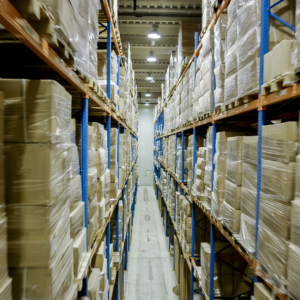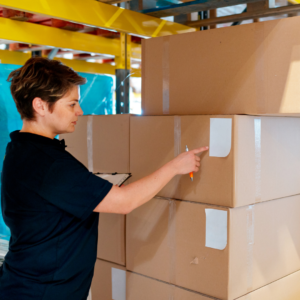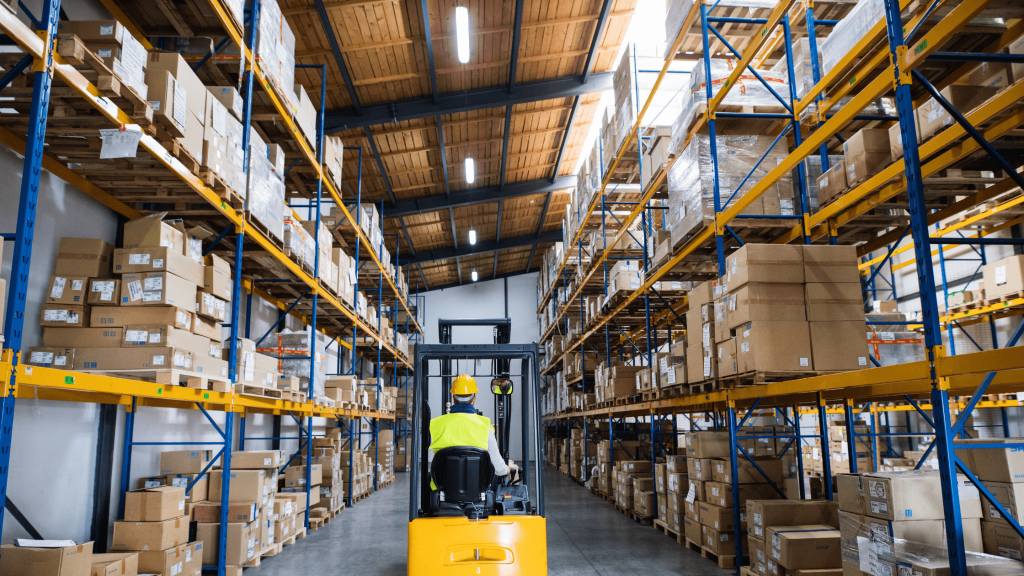Storage Racking Hacks
The way you store your products, tools, and equipment in a warehouse is an important factor to consider when it comes to efficiency. When organizing your warehouse storage racks and racking systems, there’s a lot to think about. What will the flow of movement be like within the warehouse? Or how much space will different types of products and industrial equipment, like forklifts, will take up?
For example, a pallet rack will take up one square space and allow you to store one pallet per level. However, stacking pallet racks can be stacked to create extra height. But, pallet racks, if not used to their advantages, could get in the way of forklifts that will need to get around them, disrupting the flow. So you may need a different solution.
Having an organized, free-flowing warehouse will maximize your warehouse storage rack system efficiency. It will also make it easier for inventory management and overall productivity.
So do you know the best way to organize your racking systems? First, let’s break down some of the most common types of racking and storage systems in warehouses and distribution centers.
Types of Racking Systems and Storage Systems: What Will Fit Your Warehouse Storage Needs Best?
Industrial Pallet Rack Systems

Pallet racks are some of the most common types of rack systems in warehouses and distribution centers around the world, and for good reason. They support large amounts of weight, can be customized to fit the space available, are easy to set up, and can be installed easily. This means they are a great option for storing long-term goods that won’t need to be accessed regularly but are also easy to break down and move if you are expanding your warehouse storage space.
When modifying pallet racks, it is important to keep accessibility in mind. In most cases, your warehouse workers will want to be able to access the goods from the front of the racking or pallet. This can be done by installing a rail system on the front of the racks so that you have an aisle running down both sides of all racks. To make this even easier for warehouse workers, you can install aisles on both sides of the pallet rack and use these as walkways so that goods can be easily accessed from both sides.
Pallet racks are a great option if you store a lot of medium or large-sized items that will need to be stored long-term. However, if you have a higher percentage of smaller items, another option will be better suited for your needs. Think about the use case and how you will handle products when considering which warehouse storage system to choose.
Flow Racking
Flow racking is a great option for warehouses that need to store products that are perishable (food) or products that are continuously flowing. Different from pallet racks, flow rack systems are set up in blocks of shelving that stack vertically and have an aisle down the center. This system uses gravity and rollers to push product to one end, and allows warehouse workers, or forklifts, to quickly access all products, and create a great FIFO system (first in, first out) for product rotation.
Industrial Bulk Storage System
If you have a high percentage of smaller goods that will be used regularly, then it might be more convenient to stock them on industrial bulk shelving. Industrial racks are very similar to pallet rack systems in the way it is assembled and supports the storage of material, products, and equipment across multiple levels but with much narrower aisles.
When it comes to industrial shelving, you will need to consider the materials and components used and whether they are durable enough for your warehouse environment. For example, if you are storing a lot of heavy products, an aluminum structure might not be ideal as these can deform underweight. A steel industrial shelving system would be a better option in this case. Some don’t have bottom shelving so you can better utilize floor space. There are several options to choose from for industrial shelving:
- Boltless shelving
- Mobile Aisle Shelving
- Wire Shelving
- Jacken Rack or FastRak brands
Cantilever Racking
Cantilever racks are a type of racking system that are used in many warehouses for longer products, tools, equipment. The systems allow for a larger aisle at one end which makes it easy for forklift drivers to move around and reach all areas of your warehouse storage space. Another benefit to cantilever racking systems is that they can be built higher than standard pallet racking systems because the support beams are attached at the front and back only.
In addition to providing more clearance for warehouse storage floor space, cantilever racking systems make it easier to identify asset locations and reduce the amount of time required to sort goods before stocking. If you are looking for a more cost-efficient warehouse storage solution, then pallet racking or industrial shelving may be better options. If you need a lot of space, however, then cantilever racking systems may be the solution for you.
Mezzanines and Catwalks Systems
These warehouse storage systems are not for every situation but can be a viable option to add more space if you have the ceiling height available. When installed, they sit on top of your existing racking systems and provide another level of storage which is particularly effective when using pallet racking as they can stack up to four levels high.
Forklifts are also more easily able to move around the warehouse with catwalk systems in place. They create wider aisles and can be built high enough for forklifts to go underneath them. Mezzanines and catwalk systems can be a great way to add more usable warehouse storage space. Just keep in mind that these systems may not be appropriate for every environment and will need to be designed specifically for your business’s needs.
As you can see, there are many options when choosing warehouse storage rack solutions but it is important to consider which will work best for your business and the products that need to be stored. Next, we will look at your warehouse layout, and look at the best ways to maximize your space.
Warehouse Layout: Plan For What Makes Sense For Your Facility and Leave Room For Growth
Reevaluate Design
Have you considered changing the layout and flow of your warehouse storage space? Your company’s needs may have changed over time, and you may need more space. But when was the last time the warehouse floor plan was reviewed to make sure it is still meeting current business objectives?
Some businesses outgrow their original design (and may even need a new location), while others think they are too big for their current facility and can downsize to save money. Whatever the reason, re-examining your warehouse storage layout and flow is an important part of keeping up with business growth. This should be done regularly, either every year or every few years.
The design that once served a company well may no longer meet its needs as it grows or changes. A new warehouse layout should reflect these needs and keep the business running efficiently. You can utilize the space you have by expanding or rearranging your current racking systems in a way that will best suit your business needs. By doing this, you will be able to keep operations running smoothly and provide more space available for future growth.
Zoning
Are you zoning your warehouse storage space to separate different departments or inventory categories? If not, there are many benefits to zoning:
Zoning creates a more efficient workflow.
In large operations with many employees working in the warehouse on various tasks, it is helpful to work out an organized program. Zoning divides up the warehouse racking systems into different areas for specific tasks, which can eliminate the need for workers to walk back and forth between locations multiple times per day.
The zones on the racking systems should be clearly marked so that employees know where to go when a product is needed or a task needs to be completed. In addition, there may need to be some physical separation in each zone so workers can’t see products they are not responsible for handling.
For example, if your warehouse is set up with a zone for picking or packing items, any inventory kept in this area should be sealed and wrapped so that employees responsible for these tasks do not have access to other inventory. They may also need clear barriers between zones to keep employees focused on their own departments and reduce the risk of mixing products.
Vertical Storage
Warehouse storage racks are typically arranged in aisles with horizontal rows that run from front to back. This is very effective at getting products to the point of sale or shipping, and it also keeps the workers flow moving throughout the facility. Aisles can be widened further by installing additional warehouse storage rack systems, which is added behind the existing rack systems.
Warehouse storage racks can also be arranged in a vertical configuration with multiple levels, which is especially effective when using pallet racking as they can stack up to four levels high. Vertical storage racking systems increase the amount of warehouse space that is accessible and allows room for more storage while keeping workers on foot moving along flat surfaces rather than climbing stairways or ladders. When using vertical storage, it is important to make sure the racking system is capable of supporting additional weight and that flooring below supports the extra weight as well.
Identify Aisles and Ensure Ample Aisle Space
If your aisles are too narrow, the crates and boxes may get jammed up at turnover locations. Each aisle should be wide enough to accommodate the flow of traffic and boxes or racks being turned by hand trucks. At least 4 feet is a good minimum width for most warehouse storage aisles; between 6-8 feet is considered better.
Identify each aisle with labeling so employees can easily locate them. If the racking in the aisles are arranged with multiple levels, consider color-coding each level so employees know which aisle to travel on.
Visual Organization
The warehouse storage layout should be designed in a logical way that makes it easy for employees to find what they are looking for. It is important to organize equipment, materials, and products together by type or brand name and include labels on the warehouse rack systems to make it easier for employees to get the product they need. It is also important to include labeling on racks, crates, and boxes so workers know where the product is intended to be placed or stored.
Now that we know what the ideal warehouse space should be like, let’s look at some simple solutions on how you can better organize your space.
Organization: Maximize Your Space With Clutter-Free Organization
If your warehouse is not already laid out in an organized manner that allows for maximum flow, then here are some quick solutions to make it more efficient.

Keep it Clean and Reduce Clutter
- Use a lean inventory system. Keep what you need, get rid of what you don’t.
- Dedicate a day or two per month to just cleaning up the warehouse. You never know what you may find, lost product could be anywhere in a cluttered warehouse.
- Labels, labels, and more labels. All racking, tools, shelves, and product should be organized and labeled.
Customize Based on Your Company Type
If your warehouse serves one of the following types of businesses, then use these tips to get as much out of your space as possible.
- Grocery: Make sure stock is visible by arranging products on pallets and using vertical storage racks.
- Clothing: Group items together (e.g. shirts by size, pants in a separate section, etc.) and label all crates and boxes clearly.
- Restaurant: Group items together by type or brand name and place them on pallets racks, as well as use vertical storage racks wherever possible.
- Warehousing: Group items in different categories together (e.g., food products, pharmaceuticals, hardware) to make it easier for employees to find what they are looking for.
- Shipment or Delivery: Create clearly labeled warehouse storage racks, and allow employees to use the right-sized boxes as needed (e.g. to pack and ship a lot of small items versus one big item).
Assess Space and Shelving
It is important to take inventory of existing warehouse space, including the number and size of columns for vertical storage. Calculate the total floor space needed based on your company’s overall demand and what space your facility might need for the future. Also, consider the size of aisles and plan for maximum aisle widths as well as storage locations (e.g. shelves, pallets racks).
Be sure to include warehouse storage system dimensions when planning building layout. This includes not only columns but also racks and trucks/wheeled conveyors. Adjust your warehouse’s racking systems to make the most of your available warehouse storage space.
Label and Barcoding
Labeling your inventory makes it easier to find the items you need. A labeling system should be based on a number sequence with each area of the warehouse labeled using numbers, letters, or a combination of the two.
Barcoding is a proven way of improving product traceability and efficiency, but it is also an effective way to identify individual products.
This will make it easier for employees to locate the right item because the barcode can be read by scanning equipment or from a smartphone app.
If you are using barcodes, it is important to make sure that each area of your facility has its own unique code so that employees can easily find what they need by scanning them. Proper labels should also be used to identify the area and specific slot location. Labeling and barcoding can be an investment for your business. It is sure to keep the flow or productivity moving throughout your facility.
Safety First
Always keep safety in mind when planning your warehouse storage solutions. Keeping up with regular maintenance of your storage racking systems and training of your staff will help ensure a safe workplace. Always make sure your rack systems are in good repair and check for loose screws or bolts that may be wiggling around.
Adding guarding to the front of racking columns will minimize the risk of injury from moving products. Guarding should also be added to the back of columns of the rack to prevent employees from reaching into moving parts or being hit by them.
Adding aisles also helps enhance warehouse safety protocols. Aisles allow employees to get around the storage racks and other equipment. They can also help as a buffer if something does fall over. Always allow employees to use the aisle as a safe zone during the warehouse system’s operation.
Don’t forget safety devices!
When designing your racking systems, be sure you include slip rails or other pieces of equipment. These components are specifically designed for fall protection. This will help prevent serious injury in case someone is knocked off balance and falls.
Having safety systems in place for your business will help you avoid a number of accidents and loss of product, saving your company money.
Conclusion
Warehousing is an industry in which security, efficiency, and cost-effectiveness are all important factors. This article highlighted just a few of the many warehouse racking systems and storage rack hacks. Use the hacks to help you improve your current racking system designs.
It is also worth reiterating the importance of regular inspection and maintenance to ensure safety in your warehouse. This will help prevent accidents and losses resulting from damaged equipment or injury to an employee.
If you find that what you have is not working, contact Warehouse Solutions, Inc. at (800) 278-1715. Our professionals know how to organize warehouses to run efficiently. We also offer a huge number of new and used products to fit whatever need you have.

